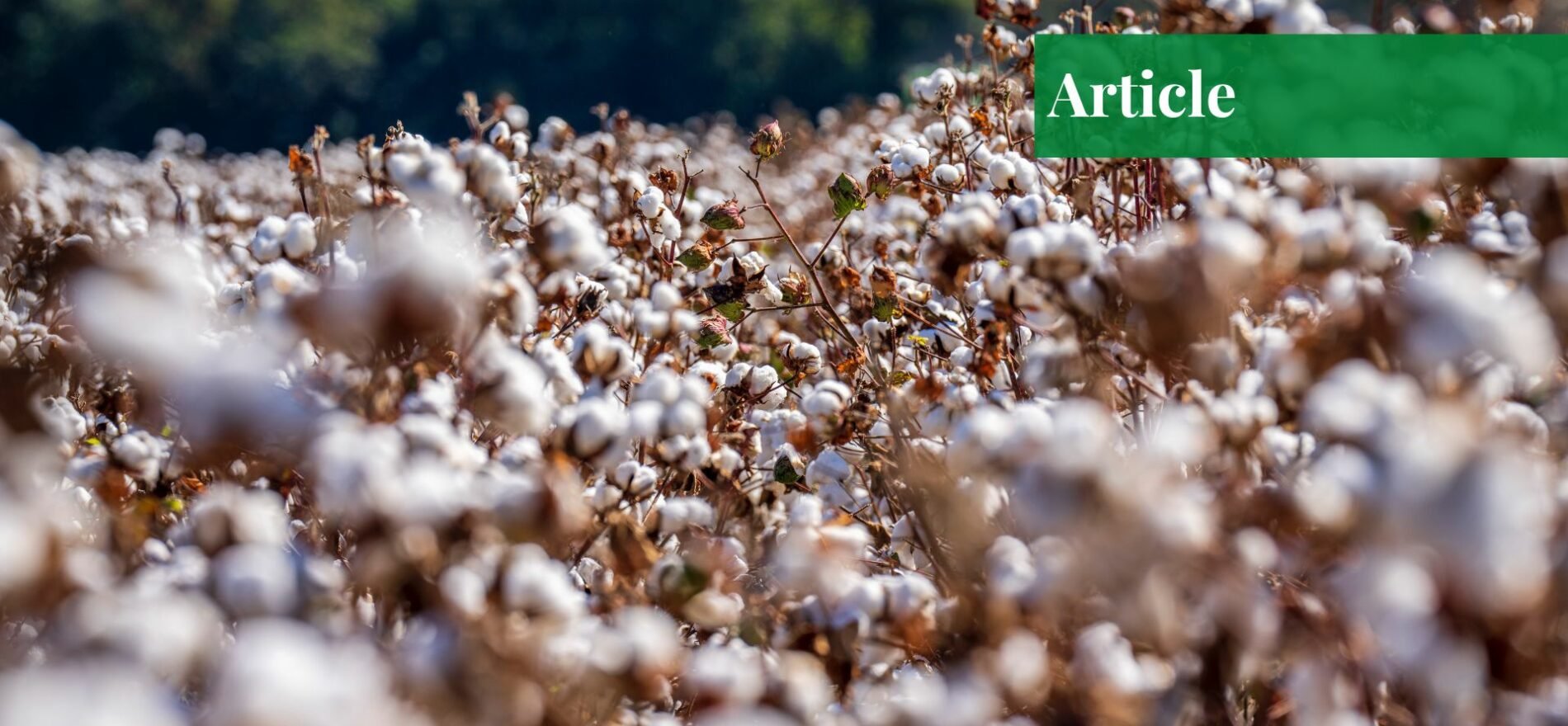Ms Fizza Batool is a student of International Relations from Kinnaird College for Women. She is particularly interested in geo-economics, geopolitics, area studies, diplomacy, conflict and peace, strategic and defense studies, political economy, and global politics of the environment.
A Brief History
The history of the cotton market in Pakistan can be traced back to the medieval civilization of the Indus Valley, where cotton was farmed and used to produce textiles. One of the world’s top growers and exporters of cotton, the market significantly contributes to the country’s economy and employment.
Pakistan was a part of British India during the colonial era, which was a significant cotton provider to the British Empire. To increase cotton output and commerce, the British introduced new cotton types, such as Gossypium Hirsutum, and enhanced the irrigation and transportation networks, but they also took advantage of the local farmers and craftspeople by imposing high taxes and tariffs and limiting their access to both domestic and international markets.
Due to competition from more affordable and higher-quality cotton from Egypt and America, the cotton industry in British India saw a collapse. Defending the interests of the cotton producers and workers was one of the driving forces behind the Pakistan Movement, which aspired to establish a distinct Muslim state from British India.
In addition to inheriting a sizable section of British India’s cotton-growing regions, Pakistan experienced several difficulties after achieving independence in 1947, including political instability, migration, war, and economic hardship. Pakistan increased its investment in increasing the amount and quality of cotton it produced as well as its value addition in the textile industry to address these issues.
Industrialization and Cotton Production in Pakistan
Pakistan’s industrialization and cotton production are intertwined since the textile industry is one of the country’s primary economic sectors. The textile sector employed 40% of the industrial workforce and contributed 8.5% to the GDP in 2019–20, according to the Pakistan Bureau of Statistics.
Pakistan is the fifth largest producer of cotton in the world, and cotton is the primary raw material for the textile sector. However, due to many issues, including water shortages, insect infestations, climate change, low-quality seeds, and a lack of research and innovation, cotton output has been falling in recent years.
The textile sector suffered from the drop in cotton output since it raised manufacturing costs and decreased its ability to compete in the international market. In comparison to India’s 30.9% and China’s 44.8%, Pakistan’s gross fixed capital creation as a percentage of GDP in 2019 was only 15.4%, according to the World Bank.
Pakistan also performs poorly in the areas of innovation, education, and skill development, all of which are crucial for modernizing and diversifying the country’s economic base. The government of Pakistan has made some efforts to resurrect the cotton industry, including granting subsidies, boosting research and development, enhancing seed quality, and encouraging modern agricultural practices.
To maintain the viability and expansion of both sectors, additional work is still required to solve the problems encountered by cotton producers and textile makers. By producing additional products, widening Pakistan’s export market, increasing job possibilities, and improving the nation’s technological capacity, industrialization may significantly increase the country’s economy and cotton output.
Cotton: A Crucial Asset for Pakistan
Due to its enormous economic and foreign exchange revenues, cotton is a crucial cash crop for Pakistan. According to the Economic Survey of Pakistan 2018-2019, cotton contributes 4.1% of the total value added in the agricultural sector and 0.8% of the country’s GDP. After India, China, the United States, and Brazil, Pakistan is the world’s fifth-largest cotton producer and fourth-largest cotton consumer.
55% of the nation’s total foreign exchange profits come from the export of cotton goods. During the monsoon season, known as the Kharif period, which runs from May to August, 15% of the country’s land is used to grow cotton as an industrial crop. Between February and April, less cotton is farmed. Since cottonseed oil is derived from cotton seeds, cotton is also a source of raw materials for the oilseed sector.
In nations that produce cotton, cotton is called “white gold” and has been accorded primary significance. Since it provides a living for millions of farmers and other people involved in the cotton value chain, cotton is a vital resource for Pakistan. In addition, cotton serves as a source of raw materials for businesses that produce garments, textiles for the house, medical equipment, and personal care items.
Given that it competes with other crops for available land and water, cotton is a critical crop for Pakistan’s food security. Due to its potential to be recycled or biodegraded, cotton may be cultivated with fewer pesticides and fertilizers than other crops, contributing to Pakistan’s environmental sustainability. Since cotton symbolizes the diversity and inventiveness of Pakistan’s population, it serves as a symbol of the country’s cultural history.
The Regulation of the Cotton Market
Pakistan is a country with a rising market economy and is regarded as one of the Next Eleven, a group of nations having the potential to have one of the greatest economies in the world in the 21st century. In the international cotton market, Pakistan is a significant player, providing raw cotton to numerous nations, including China, Bangladesh, Vietnam, and Indonesia.
To accommodate domestic demand and diversify its sources, Pakistan also buys cotton from nations such as India, Uzbekistan, Brazil, and the United States. The cotton market in Pakistan is impacted by several variables, including climate, insect infestations, global pricing, currency rates, trade regulations, and political stability.
Recent research by the International Cotton Advisory Committee (ICAC) predicts that Pakistan’s cotton production would rise by 10% in 2023–2024 because of a good growing season and enhanced insect control. The research further notes that due to increased local demand and textile exports, Pakistan’s consumption of cotton is anticipated to increase by 4% in 2023–2024.
The paper also highlights that Pakistan’s cotton trade surplus is anticipated to increase by 12% in 2023–2024 as exports would outweigh imports. For several years, the government of Pakistan has regulated the cotton market on a global level. The primary actions in this procedure are:
- Giving cotton farmers a Minimum Support Price (MSP), which ensures a just income and motivates them to increase cotton production.
- Establishing the Trading Corporation of Pakistan (TCP), a state-owned company that buys cotton from farmers at the MSP and sells it to both domestic and international customers.
- Imposing taxes and quotas on imports of cotton to safeguard domestic producers against cheap overseas competition and to guarantee a steady supply of fiber for the region’s textile industry.
- Promoting the interests of the Pakistani cotton industry through trade negotiations and participation in global forums like the World Trade Organization (WTO).
Pakistan’s cotton industry suffers from a dearth of consistent policies that can foster its growth and long-term viability. Pricing, taxation, subsidies, marketing, trade barriers, procurement, and other factors all impact the profitability and competitiveness of cotton growers and textile producers. Better coordination and cooperation amongst different stakeholders, including government agencies, research institutes, the corporate sector, civil society, and farmer groups, is hence, required.
Bangladesh’s Cotton Production
Bangladesh has grown its domestic production and exports of cotton and textile goods, making it an intense competitor for Pakistan in the global cotton market. Bangladesh’s cotton exports increased by 18% to reach $1.2 billion, while Pakistan’s cotton exports decreased by 12% to reach $1 billion.
In terms of textile exports, Bangladesh has also eclipsed Pakistan, placing second globally after China with $38 billion in 2023, while Pakistan came in eighth with $14 billion. Bangladesh’s success is mostly attributable to its varied product offering, adherence to international standards, investments in technology and innovation, and efficient use of both native and imported raw resources.
According to the USDA Foreign Agricultural Service (FAS), Bangladesh raised its cotton output in 2022–2023 by 1.3 percent, reaching 153 thousand bales, and decreased its reliance on imports from 98 to 96 percent. By using high-yielding cultivars, organic farming methods, and integrated pest control strategies, Bangladesh has also increased its cotton productivity and quality.
In contrast, Pakistan’s cotton industry has struggled with several issues, including low production, insect infestation, a lack of water supply, climate change, political instability and a lack of research and development. According to the FAS, Pakistan’s cotton output decreased by 23% in 2022–2023, hitting 5.5 million bales, the lowest amount in 30 years. Whiteflies and pink bollworm, which degrade cotton quality and yield, are also prevalent in Pakistan.
About 40% of Pakistan’s energy and gas supplies are used by the textile industry, but frequent power outages and gas shortages interrupt production and drive-up prices. Additionally, Pakistan relies a lot on low-value-added goods like yarn and gray fabric, which have slim profit margins and are subject to fierce competition from other nations.
Pakistan also does not adhere to international norms and rules for quality control, environmental protection, and labor rights, which harms its standing and market access. Pakistan must thus act rapidly to revive its cotton industry and increase its competitiveness in the global market.
Increasing public and private investment in research and development, enhancing irrigation effectiveness and water management, promoting biotechnology and climate-resilient varieties, diversifying Pakistan’s product range and markets, modernizing its infrastructure and technology, and ensuring compliance with international standards and regulations are some of the actions Pakistan should take.
Conclusion
From a global perspective, Pakistan’s cotton market has a variety of obstacles and possibilities. To satisfy the rising demand and lofty expectations of foreign customers, the country must increase its production, quality, and competition. The economic future of Pakistan depends on its cotton production, but it is difficult to make progress due to the competition from Bangladesh, the political instability and violence in the country, and the environmental and social issues related to the cotton sector.
Pakistan needs to adopt a comprehensive strategy to overcome these obstacles, one that focuses on developing its infrastructure and governance, diversifying its exports, and adding value, improving trade relations and market access, fostering innovation and quality standards, addressing the social and environmental issues facing the industry, and ensuring the welfare and empowerment of cotton farmers and workers.
If you want to submit your articles, research papers, and book reviews, please check the Submissions page.
The views and opinions expressed in this article/paper are the author’s own and do not necessarily reflect the editorial position of Paradigm Shift.



















